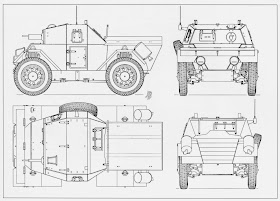This was the Funkwagen version of the eight-wheeled armoured
car-identical to the Sd.Kfz.231 (8-Rad) as regards its armament and traversing
turret. The medium-range wireless equipment, however, was provided with a large
frame-aerial mounted horizontally above the turret, extending approximately the
whole length of the vehicle and curved down at each end. It was mounted on a
pivot above the turret at the front and on two stays at the rear of the
vehicle. The pivot mounting at the front allowed the turret to traverse; but
when traversed to the rear, there was a danger of shooting away the supporting
stays at low elevation and the rear of the aerial at high elevation. Like the
Sd.Kfz.231 (8-Rad), this vehicle had a crew of four.
In later models, the horizontal frame-aerial was replaced by
a rod-aerial on the turret roof and a star aerial on the centre of the rear
deck. The radio equipment in this vehicle was expensive and very complicated,
and it therefore proved difficult to maintain.
Characteristics
(differing from those of the Sd. Kfz.231 (8-Rad)
Weight, unladen: 7700kg (7.70 tons).
Weight, fully laden: 8800kg (8.80 tons) .
Axle loadings (all axles): 2275kg (2.3 tons).
Height, overall: 2900mm (9.50ft).
Armament: As for Sd.Kfz.231 but with the omission of the
7.62mm coaxial machine-gun.
Communication: R/T and WIT (medium-range) transmitter and
receiver.





